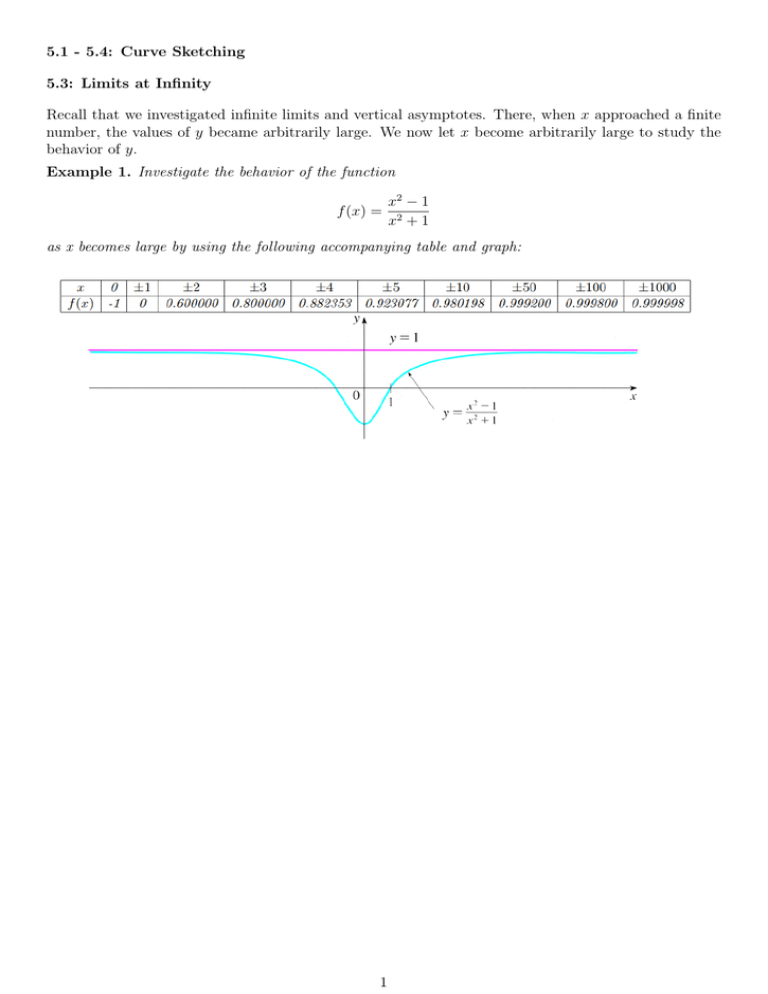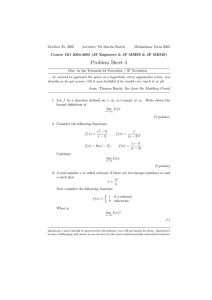5.1 - 5.4: Curve Sketching 5.3: Limits at Infinity
advertisement

5.1 - 5.4: Curve Sketching 5.3: Limits at Infinity Recall that we investigated infinite limits and vertical asymptotes. There, when x approached a finite number, the values of y became arbitrarily large. We now let x become arbitrarily large to study the behavior of y. Example 1. Investigate the behavior of the function f (x) = x2 − 1 x2 + 1 as x becomes large by using the following accompanying table and graph: 1 Definition: Given a function f (x) 1. If f (x) approaches the number L as x becomes positively large without bound, then we say that L is the limit of f (x) as x approaches ∞, and we write lim f (x) = L. x→∞ 2. If f (x) approaches the number K as x becomes a large negatively large without bound, then we say that K is the limit of f (x) as x approaches −∞, and we write lim f (x) = K. x→−∞ We refer to the lines y = L and y = K as horizontal asymptotes. 3. If lim f (x) = L, x→±∞ then the line y = L is a horizontal asymptote for the graph of f (x). Notice: A function can have zero, one, or two horizontal asymptotes. Most of the Limit Laws that we studied in previous sections also hold for limits at infinity. Important Rules for Calculating Limits: 1. If r > 0 is a rational number, c is any real number, then lim xr = ∞. x→∞ c = 0. x→∞ xr 2. If r > 0 is a rational number, c is any real number, and xr is defined for x < 0, then lim c = 0. x→−∞ xr lim 3. Given p(x) = an xn + an−1 xn−1 + · · · + a1 x + a0 , a polynomial of degree n (i.e. an 6= 0), then lim p(x) = lim an xn , x→∞ x→∞ lim p(x) = lim an xn . x→−∞ x→−∞ 2 Facts: Given a rational function p(x) q(x) f (x) = 1. If the degree of p(x) is greater than the degree of q(x), then there is NO HA. 2. If the degree of p(x) is less than the degree of q(x), then there is ONE HA, y = 0. 3. If the degree of p(x) is equal to the degree of q(x), then there is ONE HA, y = where an and bn are the leading coefficients of p(x), q(x) respectively. Note: A rational function can have at most ONE HA. Example 2. Find the limits: a) 2x3 x→∞ x2 + 1 lim b) √ 3x2 − 1 x2 + 1 lim x→∞ c) 2x3 x→∞ x3 − 3x2 + 3x − 1 lim 3 an , bn d) lim (x7 + x2 ) x→−∞ e) √ 2x + 1 + 1 lim √ x→∞ 2x + 1 − 1 f) lim (x4 − x3 + x2 − x + 5) x→∞ g) lim ex x→∞ lim ex x→−∞ lim lnx. x→∞ Example 3. Find the horizontal and vertical asymptotes of the curves a), b), and c) in the previous example 4






